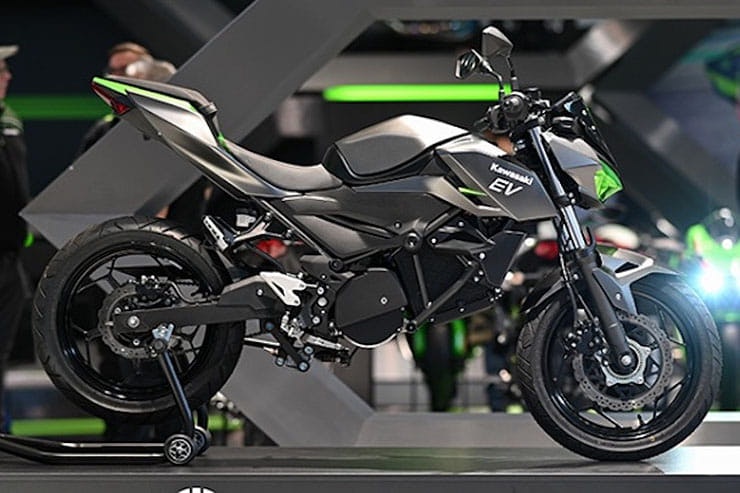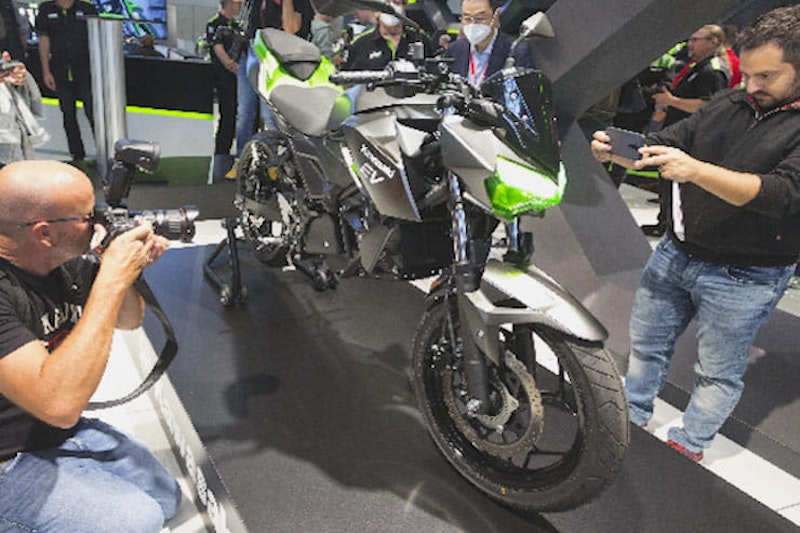Kawasaki has given the media and the general public an opportunity to get up close and personal with its inaugural electric motorcycle - the Kawasaki EV - at the 2022 Intermot show in Germany.
The first of up to ten full-size electric or alternatively powered Kawasaki models slated to arrive by 2025, the EV represents the initial steps in the firm’s objective to establish itself as an industry leader ahead of a broad shift towards electric over the next 10 to 15 years
While the Kawasaki EV on display in Cologne is still branded as a ‘prototype’, it is thought to be nearly production ready.
The EV is one of two new alternatively powered motorcycles Kawasaki surprisingly revealed during a demonstration run in front of spectators attending the 2022 Suzuka 8 Hours in August, together with a larger Hybrid sportsbike.
Wowing audiences with its eerily quiet performance as it completed a few runs down the Suzuka home straight, its unveiling at Intermot is nonetheless the first time the EV has been seen on static display in public.
While Kawasaki is yet to reveal the finer technical details of the EV - which is roughly the size of the Z250, sold in Z400 configuration in the UK - previously reported registration documents confirm it will produce 14.8hp, the equivalent of a 125cc petrol-fuelled engine.
In terms of design, the Kawasaki EV slots neatly into the firm’s range with a similar template to that of its other ‘Z’ modes, albeit with some individual traits to help it stand out from its siblings.
Indeed, from a side-profile, the Kawasaki EV shrouds its electric powertrain remarkably well thanks to some smart design touches, such housing the larger radiator behind an exposed trellis frame and a sculpted part-fairing that helps disguise the battery case to look more like an engine at first glance.
Another notable feature of the design is the higher set tail portion, which could be explained by Kawasaki employing some clever packaging solutions to house the battery cells. It gives the Kawasaki EV more of a slimline appearance and traditional profile than other electric models, such as the LiveWire Del Mar and Zero SR/F.
Though labelled as a prototype, the Kawasaki EV - thought to be a ‘working title’ for now - isn’t expected to undergo many changes before it hits the roads.
Kawasaki to still invest in ICE technology
While presenting the EV to assembled media, Kawasaki Motors Europe manager Masaya Tsurono also divulged more details about the Japanese firm’s aspirations for the future, particularly its investment towards hydrogen power having reportedly signed a major deal with auto giants Toyota to speed up development of technology and infrastructure.
However, Kawasaki also took the opportunity to confirm it remains committed to developing greener solutions for the internal combustion engine, echoing the sentiments of rivals Honda.
During a presentation laying out its future plans for introducing electric models, the world’s largest motorcycle manufacturer also emphasised it will maintain production and development of the traditional ICE beyond 2040 to cater for markets not bound by deadlines to phase fossil fuels out.
As a result, Kawasaki says it will embark on fresh research on bio-fuels and e-fuels as a means of pushing the benchmark on reducing the carbon footprint of ICE models, in addition to its commitment towards electric, hybrid and hydrogen power solutions.
It isn’t clear, however, whether this represents a change of philosophy for Kawasaki after announcing at the 2021 EICMA show that it was planning to offer only electric and alternatively powered motorcycles in its range from 2035, or whether this ongoing commitment will span the next decade only.
Share on social media:

